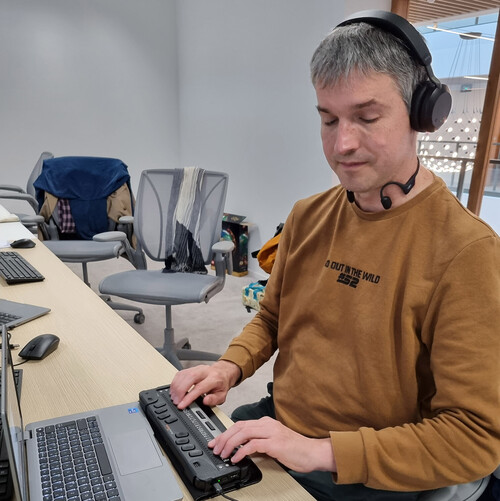Use the drop-down summary to access the articles in the folder.
Terms of republication
You can republish this article for free on your website, blog, etc.
Joint perspectives
Interview with Valérie Renaudin, Director of the GEOLOC laboratory, Michel Ferrant, a volunteer with the Nantes branch of the Valentin Haüy Association, and David Galantin, a member of the CLISSAA Voir et Agir association.
How did you identify the needs that the ACCESS project was designed to meet?
Valérie Renaudin: For the inmob project, we needed visually impaired testers. So we contacted local associations. But once we were out in the field with the volunteers, we needed to be able to interact with them directly and invite them to share their experiences. And that's when we discovered that there was an entire vocabulary and culture that we didn’t know. ACCESS was born to help us work with visually impaired people.
Michel, David, what drew you to the research project?
Michel Ferrant: I volunteered because I've been interested in anything to do with technology for a long time. I'm also a volunteer trainer in specialised computing. So I was hoping to help move things forward.
David Galantin: I was interested in what Valérie and her team had to offer. Improving how we get around is a subject that concerns all visually impaired people, and accessible information goes hand in hand with it all.
Aside from what inmob is hoping to deliver with its GPS navigation system, what have you gained from your involvement in these projects?
Michel: I found it interesting to spend time with young people, young researchers, sometimes from abroad, to talk with them and share our points of view.
David: I was curious to learn more about the sometimes surprising way researchers work! For inmob, we were doing laps around the track with sensors on us - we didn’t how it would connect with reality. But the researchers were there to explain their work to us. Our discussions with the whole team opened my mind to realities that I didn't know about, and they discovered how to include visually impaired people. With ACCESS, they've done a great job: the contrast, fonts and texts make their website accessible.
Valérie: We've been able to implement tools that make our work more accessible and communication easier with our potential testers, in particular with a new online form.The positive feedback we’ve received from disability networks about the accessibility of the university's website shows that this long-term work is bearing fruit.
Find out more about the project leaders
Valérie Renaudin
A geomatics engineer (ESGT, 1999) with a PhD in Computer Science, Communication and Information Science (EPFL, 2009), Valérie Renaudin is currently Director of Research at Université Gustave Eiffel. She leads and coordinates the work of the GEOLOC team (geopositioning laboratory) on the school's Nantes campus. The inmob project and her encounters with the world of visually impaired people led her to develop ACCESS.

Michel Ferrant
The Valentin Haüy Association is one of France's oldest associations dedicated to helping visually impaired people. Founded in 1889, it has branches in every department of France. Michel Ferrant has been an active volunteer with the association for many years and used to be a teacher at the Institut des Hauts Thébaudières in Nantes. Keen to learn and share knowledge, he decided to get involved in the work of Géoloc and ACCESS.

David Galantin
The Nantes-based CLISSAA Voir et Agir association was created in 2003 by visually impaired people who wanted to get together and enjoy a variety of activities: yoga, tandem cycling, dance, English conversation, improv theatre, and many more. The general-interest association has almost 150 members, including David Galantin. This web developer by trade is a member of the association's communication and website committee alongside Rémy Queuniet, Régine Rigaud and Laurence Roussel, and has contributed to the ACCESS and inmob projects at Université Gustave Eiffel.
![[Translate to English:] Licence creative commons BY-SA 4.0 [Translate to English:] Licence creative commons BY-SA 4.0](https://reflexscience.univ-gustave-eiffel.fr/fileadmin/ReflexScience/Accueil/Logos/CCbySA.png)